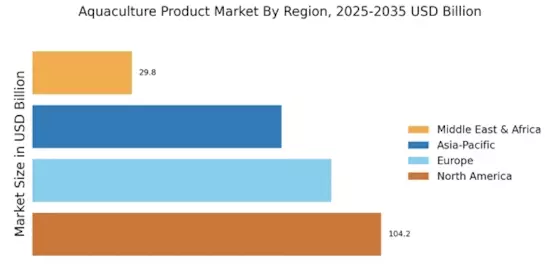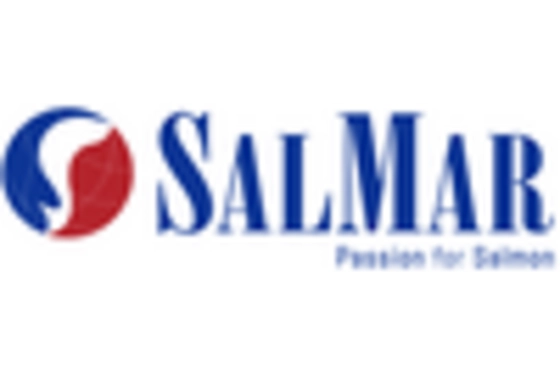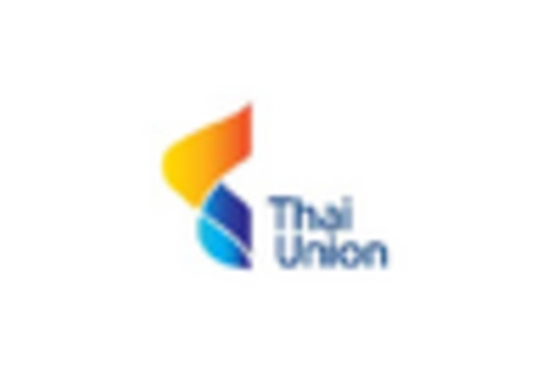Rising Seafood Consumption
The increasing The Aquaculture Product Industry. As populations grow and dietary preferences shift towards healthier protein sources, seafood consumption has surged. Reports indicate that per capita seafood consumption has risen significantly, with estimates suggesting an increase from 20 kg in 2010 to over 25 kg in 2025. This trend is likely to continue, as consumers become more health-conscious and seek sustainable food sources. The Aquaculture Product Market is positioned to meet this demand, providing a reliable supply of fish and shellfish. Furthermore, the rise of aquaculture as a sustainable alternative to wild fishing is expected to bolster market growth, as it offers a controlled environment for fish farming, reducing overfishing pressures on natural stocks.
Government Support and Policy Frameworks
Government initiatives and supportive policy frameworks are pivotal in shaping the Aquaculture Product Market. Many countries are recognizing the economic potential of aquaculture and are implementing policies to promote its growth. This includes financial incentives, research funding, and infrastructure development aimed at enhancing aquaculture production. For example, several nations have established aquaculture development plans that outline strategies for sustainable growth and resource management. The global aquaculture production is projected to reach 200 million tons by 2030, largely supported by favorable government policies. Such initiatives not only bolster production but also ensure that the industry adheres to environmental and social standards, thereby enhancing the overall sustainability of the Aquaculture Product Market.
Sustainability and Environmental Concerns
Sustainability is a critical driver in the Aquaculture Product Market, as consumers and regulators increasingly prioritize environmentally friendly practices. The industry faces pressure to adopt sustainable farming methods that minimize ecological impact, such as reducing water usage and preventing pollution. Certification programs, such as the Marine Stewardship Council (MSC) and the Aquaculture Stewardship Council (ASC), are gaining prominence, encouraging producers to adhere to sustainable practices. This shift is reflected in market data, which indicates that sustainably sourced seafood is becoming a preferred choice among consumers, with sales of certified products rising by over 30% in recent years. As awareness of environmental issues grows, the Aquaculture Product Market must adapt to meet these expectations, potentially leading to increased market share for sustainably produced aquaculture products.
Technological Advancements in Aquaculture
Technological innovations are transforming the Aquaculture Product Market, enhancing productivity and sustainability. The integration of advanced technologies such as automated feeding systems, water quality monitoring, and genetic improvements in fish breeding is becoming increasingly prevalent. These advancements not only optimize production efficiency but also improve the health and growth rates of aquaculture species. For instance, the use of recirculating aquaculture systems (RAS) has gained traction, allowing for higher stocking densities and reduced environmental impact. The market is projected to witness a compound annual growth rate (CAGR) of approximately 6% from 2025 to 2030, driven by these technological enhancements. As aquaculture operations become more efficient, the industry is likely to attract further investment, fostering innovation and growth.
Consumer Preferences for Healthy and Sustainable Products
The shift in consumer preferences towards healthy and sustainable food options is a significant driver of the Aquaculture Product Market. As awareness of health issues and environmental sustainability increases, consumers are actively seeking seafood products that are both nutritious and responsibly sourced. Market Research Future indicates that nearly 70% of consumers are willing to pay a premium for sustainably farmed seafood. This trend is influencing product offerings, with aquaculture producers focusing on transparency in sourcing and production practices. The demand for organic and eco-labeled seafood is on the rise, prompting the Aquaculture Product Market to adapt its strategies to meet these evolving consumer expectations. As a result, the industry is likely to experience growth as it aligns with the values of health-conscious and environmentally aware consumers.


















Leave a Comment